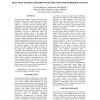Free Online Productivity Tools
i2Speak
i2Symbol
i2OCR
iTex2Img
iWeb2Print
iWeb2Shot
i2Type
iPdf2Split
iPdf2Merge
i2Bopomofo
i2Arabic
i2Style
i2Image
i2PDF
iLatex2Rtf
Sci2ools
ICIP
2009
IEEE
2009
IEEE
Real-time optimal-memory image rotation for embedded systems
Skew-corrected document images are necessary for subsequent downstream operations such as archiving, printing or improving OCR performance. Image rotation is a necessary and more expensive step in achieving skew correction of document images. Other applications of rotation include, image registration and orientation correction. Traditional image rotation algorithms [2-4] such as three-shear rotation [1] require three separable shears of the image. The embedded use of such techniques in scanners/printers presents technical challenges, since the memory available is limited and/or the document image is only available progressively in chunks of say 32 or 64 rows (swaths). Traditional image rotation algorithms require the entire image to be available before commencing the rotation operation. This paper presents an approach that allows image rotation using swaths of the image thus minimizing the overall memory requirement. We theoretically prove that the number of image swaths that are to b...
Related Content
| Added | 19 Feb 2011 |
| Updated | 19 Feb 2011 |
| Type | Journal |
| Year | 2009 |
| Where | ICIP |
| Authors | Serene Banerjee, Anjaneyulu Kuchibhotla |
Comments (0)

